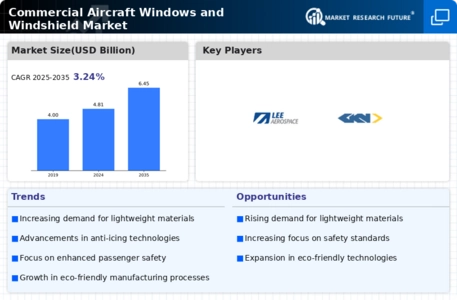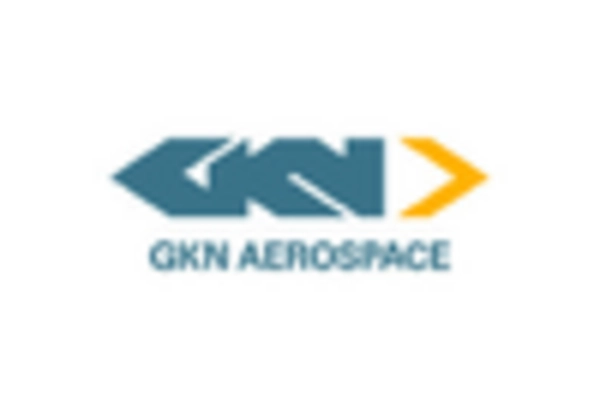Rising Air Travel Demand
The increasing demand for air travel is a primary driver of the Commercial Aircraft Windows and Windshield Market. As more individuals and businesses opt for air travel, airlines are expanding their fleets to accommodate this growth. According to recent data, the number of air passengers is projected to reach 8.2 billion by 2037, necessitating the production of more aircraft. This surge in demand directly influences the need for high-quality windows and windshields, as they are essential for passenger safety and comfort. Consequently, manufacturers are focusing on enhancing the durability and performance of these components to meet the evolving requirements of airlines. The Commercial Aircraft Windows and Windshield Market is thus poised for significant growth as it aligns with the broader trends in the aviation sector.
Growth of the Aerospace Sector
The overall growth of the aerospace sector is a significant driver for the Commercial Aircraft Windows and Windshield Market. With increasing investments in aviation infrastructure and the expansion of airline networks, the demand for new aircraft is on the rise. This growth is supported by government initiatives aimed at boosting the aerospace industry, which in turn stimulates the need for high-quality windows and windshields. As airlines modernize their fleets to enhance operational efficiency and passenger experience, the demand for advanced window and windshield technologies is expected to increase. The Commercial Aircraft Windows and Windshield Market stands to benefit from this upward trend, as manufacturers align their offerings with the evolving needs of the aerospace sector.
Advancements in Material Technology
Innovations in material technology are reshaping the Commercial Aircraft Windows and Windshield Market. The introduction of lightweight, high-strength materials such as polycarbonate and advanced composites is enhancing the performance of aircraft windows and windshields. These materials not only reduce the overall weight of the aircraft, contributing to fuel efficiency, but also improve safety and durability. For instance, the use of these advanced materials can lead to a reduction in maintenance costs and an increase in the lifespan of windows and windshields. As airlines seek to optimize operational efficiency and reduce costs, the demand for technologically advanced materials in the Commercial Aircraft Windows and Windshield Market is likely to rise, driving further innovation and investment in this sector.
Increased Focus on Passenger Safety
Passenger safety remains a paramount concern for airlines, significantly influencing the Commercial Aircraft Windows and Windshield Market. Regulatory bodies are continuously updating safety standards, which necessitates the use of high-quality materials and designs in aircraft windows and windshields. Recent regulations have emphasized the need for enhanced impact resistance and thermal performance, compelling manufacturers to innovate and comply with these standards. This focus on safety not only protects passengers but also enhances the reputation of airlines, making it a critical driver for the market. As airlines invest in newer aircraft with improved safety features, the demand for advanced windows and windshields is expected to grow, further propelling the Commercial Aircraft Windows and Windshield Market.
Sustainability and Environmental Regulations
The push for sustainability and adherence to environmental regulations are increasingly shaping the Commercial Aircraft Windows and Windshield Market. Airlines are under pressure to reduce their carbon footprint, leading to a demand for more efficient aircraft designs. This includes the integration of eco-friendly materials in the production of windows and windshields. Manufacturers are exploring options such as recyclable materials and energy-efficient production processes to meet these sustainability goals. As environmental regulations become more stringent, the Commercial Aircraft Windows and Windshield Market must adapt to these changes, potentially leading to innovations that align with global sustainability initiatives. This trend not only addresses regulatory compliance but also appeals to environmentally conscious consumers.


















Leave a Comment